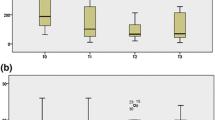Abstract
Surgical reconstruction of the anterior cruciate ligament (ACL) may reduce, but it does not always eliminate, knee and body instability because of a persisting proprioceptive deficit. In order to enhance body stability, a new protocol of treatment has been proposed consisting of mechanical vibration (100 Hz frequency and < 20 μm amplitude) of the quadriceps muscle in the leg that has undergone ACL reconstruction. In our trials, stimulation was performed when the quadriceps muscle was kept isometrically contracted. Treatment was started one month after surgery. Vibration was applied for short periods over three consecutive days. Nine months after treatment, postural stability was re-evaluated with the subjects standing on one leg with open and with closed eyes. The postural stability of the subjects having undergone vibration treatment, standing on the operated leg was significantly improved one day after treatment when evaluated as mean of speed and elliptic area of the center of pressure. The improvement persisted and increased during the following weeks. Peak torques of the operated leg extensor muscles also increased and reached values close to that of the leg, which had not been operated. Conversely, the balance of the untreated subjects standing on the operated leg did not improve and the restoration of the extensor muscle peak torque was poor. It is concluded that short lasting proprioceptive activation by vibration may lead to a faster and more complete equilibrium recovery probably by permanently changing the network controlling knee posture.





Similar content being viewed by others
References
Ahtiainen JP, Pakarinen A, Alen M, Kraemer WJ, Hakkinen K (2003) Muscle hypertrophy, hormonal adaptations and strength development during strength training in strength-trained and untrained men. Eur J Appl Physiol 89(5):555–563
Bonfim TR, Paccola CAJ, Barela JA (2003) Proprioceptive and behavior impairments in individuals with anterior cruciate ligament reconstructed knees. Arch Phys Med Rehabil 84(8):1217–1223
Bovenzi M (1998) Exposure-response relationship in the hand-arm vibration syndrome: an overview of current epidemiology research. Int Arch Occup Environ Health 71:509–519
Cannon S E, Rues JP, Melnick ME, Guess D (1987) Head-erect behavior among three preschool-aged children with cerebral palsy. Phys Ther 67:1198–1204
Fitzgerald G, Axe M, Snyder-Mackler L (2000) The efficacy of perturbation training in non-operative anterior cruciate ligament rehabilitation programs for physical active individuals. Phys Ther 80(2):128–140
Gandevia SC (2001) Spinal and supraspinal factors in human muscle fatigue. Physiol Rev 81:1725–1789
Jerosh J, Prymka M (1996) Knee joint proprioception in normal volunteers and patients with anterior cruciate ligament tears, taking special account of the effect of a knee bandage. Arch Orthop Trauma Surg 115:162–166
Johansson H (1991) Role of knee ligaments in proprioception and regulation of knee stiffness. J Electromyogr Kinesiol 1:158–179
Johannsen L, Akermann H, Karnath H-O (2003) Lasting amelioration of spatial neglect by treatment with neck muscle vibration even without concurrent training. J of Rehabil Med 35:249–253
Kandel ER, Schwartz JH, Jessell TM (eds) (1991) In Principles of neurosciences. Elsevier, NY, 1009–1031
Karnath HO, Konczak J, Dichgans J (2000) Effect of prolonged neck muscle vibration on lateral head tilt in severe spasmodic torticollis. J Neurol Neurosurg Psychiatry 69:658–660
Kennedy J, Alexander I, Hayes K (1982) Nerve supply of the human knee and its functional importance. Am J Sports Med 10:329–335
Lephart SM, Henry TJ (1995) Functional rehabilitation for the upper and lower extremity. Orthop Clin North Am 26:579–592
Ljubisavljevic M, Vukevic IS, Radovanovic S, Milanovic S, Anastasijevic K (1997) Effect of cutaneous afferent input on fatigue-induced changes in fusimotor activity of decerebrated cats. Neuroscience 79:935–942
Lings S, Leboeuf-Yde C (2000) Whole-body vibration and low back pain: a systematic, critical review of the epidemiological literature 1992–1999. Int Arch Occup Environ Health 73:290–297
Liu-Ambrose T, Taunton JE, MacIntyre D, McConkey P, Khan KM (2003) The effects of proprioceptive or strength training on the neuromuscular function of the ACL reconstructed knee: a randomized clinical trial. Scand J Med Sci Sports 13(2):115–123
Moritani T, DeVries HA (1979) Neural factors versus hypertrophy in the time course of muscle strength gain. Am J Phys Rehabil 58:115–130
Necking LE, Lundstrom R, Dahlin LB, Lundborg G, Thornell LE, Friden J (1996) Tissue displacement is a causative factor in vibration-induced muscle injury. J Hand Surg 21(6):753–757
Petit J, Filippi GM, Gioux M, Hunt CC, Laporte Y (1990) Effects of tetanic contractions of motor units of similar type on the initial stiffness to ramp stretch of cat Peroneus longus muscle. J Neurophysiol 64:1724–1732
Rosenkranz K, Rothwell JC (2003) Differential effect of muscle vibration on intracortical inhibitory circuits in humans. J Physiol 551(2):649–660
Rosenkranz K, Rothwell JC (2004) The effect of sensory input and attention on the sensorimotor organization of the hand area of the human motor cortex. J Physiol 561(1):307–320
Shiraishi M, Mizuta H, Kubota K, Otsuka Y, Nagamoto N, Takagi K (1996) Stabilometric assessment in the anterior cruciate ligament-reconstructed knee. Clin J Sport Med 6:32–39
Wilk KE, Reinold MM, Hooks TR (2003) Recent advances in the rehabilitation of isolated and combined anterior cruciate ligament injuries. Orthop Clin North Am 34(1):107–137
Wolf SL, Segal RL, Heter ND, Catlin PA (1995) Controlateral and long latency effects of human biceps brachii stretch reflex conditioning. Exp Brain Res 107:96–102
Wolpaw JR (1994) Acquisition and maintenance of the simplest motor skill: investigation of CNS mechanisms. Med Sci Sports Exerc 26:1475–1479
Wolpaw JR (1997) The complex structure of a simple memory. TINS 20:588–594
Wolpaw JR, Tennissen AM (2001) Activity-dependent spinal cord plasticity in health and disease. Annu Rev Neurosci 24:807–843
Yue G, Cole KJ (1992) Strength increases from the motor program: comparison of training with maximal voluntary and imagined muscle contractions. J Neurophysiol 67:1114–1123
Acknowledgments
This research was supported by grants from the MIUR and ISPELS. Proof reading of the text was done by native-English speakers.
Author information
Authors and Affiliations
Corresponding author
Rights and permissions
About this article
Cite this article
Brunetti, O., Filippi, G.M., Lorenzini, M. et al. Improvement of posture stability by vibratory stimulation following anterior cruciate ligament reconstruction. Knee Surg Sports Traumatol Arthrosc 14, 1180–1187 (2006). https://doi.org/10.1007/s00167-006-0101-2
Received:
Accepted:
Published:
Issue Date:
DOI: https://doi.org/10.1007/s00167-006-0101-2




